Shoal Bay Receiving Station
Introduction
The Shoal Bay Receiving Station east of Darwin is one part of the Darwin node of the Defence High Frequency Communications System. The second part, the Humpty Doo Transmit Station, is located about 60 kms south of Darwin. Shoal Bay has two primary roles: the interception of satellite communications and the interception of high frequency signals. Consequently the station is made up of two distinct facilities: a high frequency antenna farm on the eastern side of the station, and a satellite communications monitoring and interception station .
The satellite communications station, codenamed LARKSWOOD, is one of three principal Foreign Satellite / Communications Satellite (FORNSAT/COMSAT) interception facilities in Australia, together with the FORNSAT component of the Joint Defence Facility Pine Gap, and the FORNSAT/COMSAT component of the Australian Defence Satellite Communications Station at Kojarena in Western Australia.
The high frequency antenna farm is the receiving station for the Darwin node of the Defence High Frequency Communications System, paired with the Humpty Doo Transmission Station.
According to a reply to a parliamentary question in 2005, the station at that time housed a total of 17 antennas. 85 personnel worked at the station, made up of Navy, Air Force, and Army staff, as well as Defence civilians and contractors. Boeing Australia was the largest contractor, with 45 staff associated with the site.
From at least 2005 until 2020, the FORNSAT/COMSAT station consisted of eleven large uncovered parabolic antennas, including eight 16-18 m diameter parabolic antennas, one 10 m and two 7 m diameter antennas.
In late 2020 two of four 16-18 m antennas in the northern-most row were replaced.
Between 2020 and 2022 three 11 m. diameter uncovered parabolic antennas were installed in the eastern corner of the satcom compound, making a total of fourteen large parabolic antennas at Shoal Bay suitable for monitoring of foreign satellites.
In October 2022 the Defence Industry Minister announced a $1.96 bn investment in upgrading the high frequency system, including a new communication site near Darwin, likely involving shifting the high frequency receiving component of the Shoal Bay station.
According to a November 2022 US Defense Information Systems Agency document, the Australian Signals Directorate will locate this new Darwin facility at Mount Bundey. [HT to VS.]
John Holloway, Defense Information Systems Agency, ‘DISA briefing to the US-AUS-NZ, Strategic Defense Communications Management Group General Meeting on DoD HF Modernization efforts’, AFCEA [Armed Forces Communications & Electronics Association International], 15 November 2022, [n.d. in doc], at As Australia’s principal source for interception of Indonesian military and civilian communications, Shoal Bay has had a particularly role in Australian government understanding of Indonesian military activities in East Timor from 1975 to 1999, an understanding usually withheld from the Australian public. In February 2014 documents provided by Edward Snowden to the New York Times and Fairfax Media revealed that through Shoal Bay the Australian Signals Directorate (ASD, formerly DSD) had comprehensively penetrated the Indonesian civilian telephone system. By at least 2012 ASD accessed bulk call data from Indosat, and by 2013 had obtained almost 1.8 mn. encrypted master keys allowing it to decrypt mobile calls through the Telkomsel Mobile telephone network. Between 2010 and 2012, ASD offered the NSA surveillance monitoring records of communications between the Indonesian government and the US legal firm advising Indonesia in trade negotiations with the United States. The NSA accepted the ASD offer, and, according to the NSA documents, ASD “able to continue to cover the talks, providing highly useful intelligence for interested US customers”.
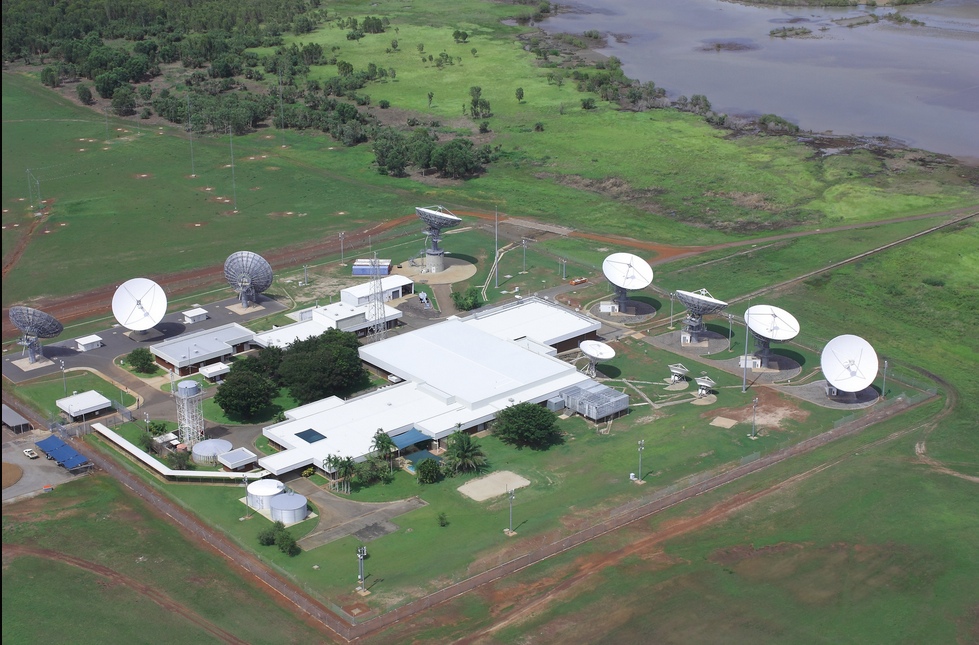
Shoal Bay Receiving Station, Allan Laurence, 1 January 2013.
Source: Allan Laurence/Grey Albatross, flickr, 1 January 2013, at
http://www.flickr.com/photos/grey_albatross/8331461207/in/photostream/
Shoal Bay Receiving Station, satellite communications antennas
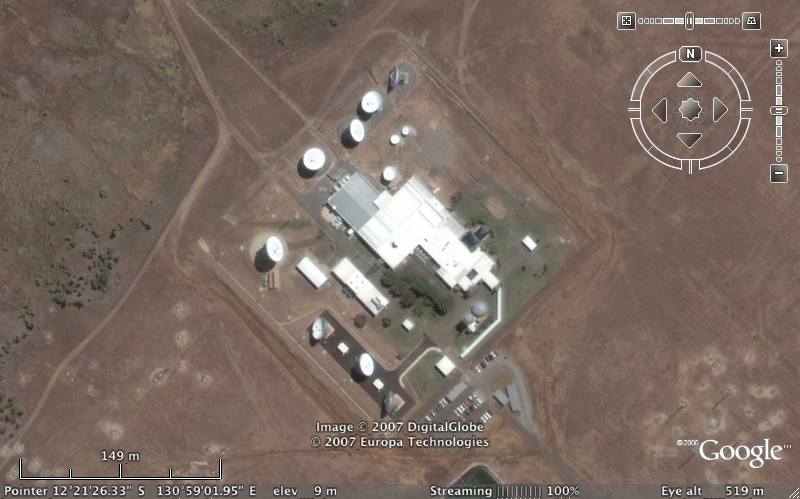
- Shoal Bay Receiving Station, Google Earth, 2007.
[250 KB version, Click here]

Shoal Bay Receiving Station, Darwin Google Earth, 8 November 2020
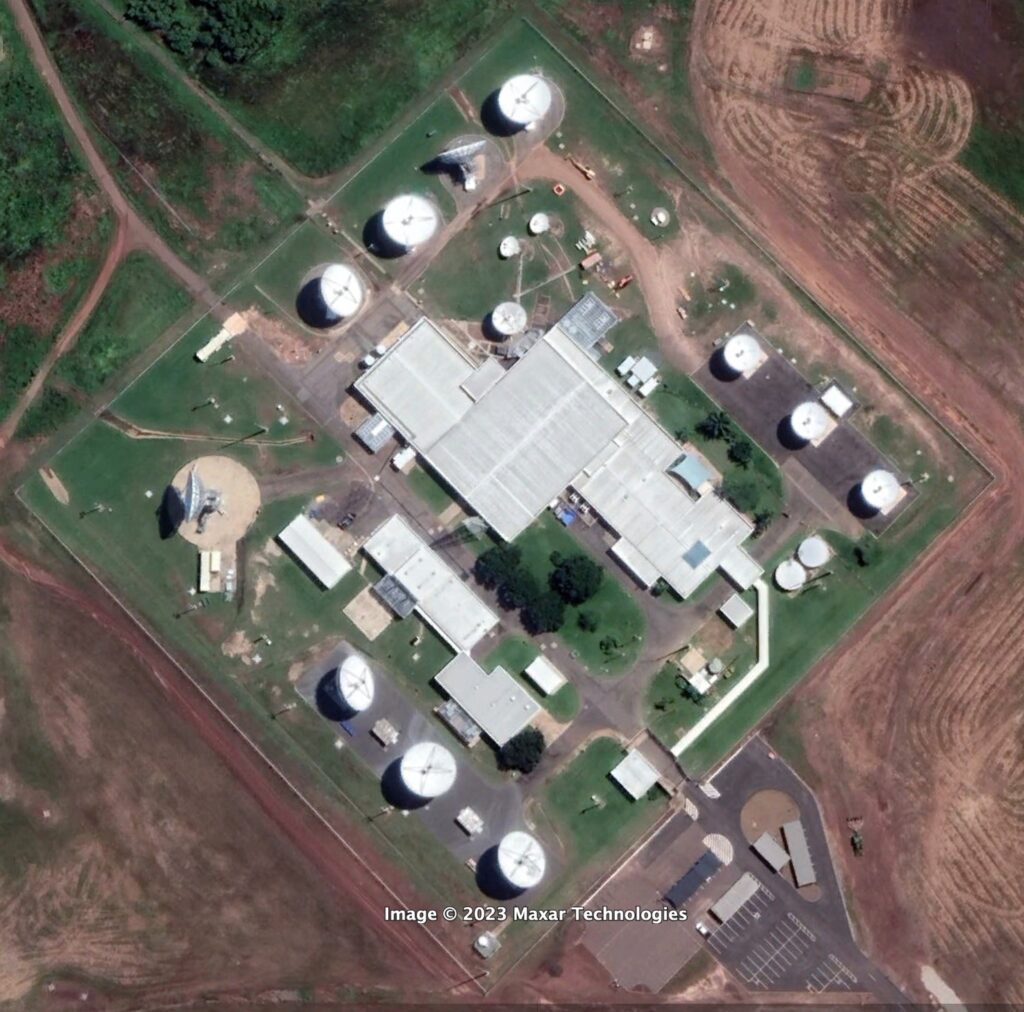
Shoal Bay Receiving Station, Darwin Google Earth, 20 March 2022
Shoal Bay Receiving Station, Darwin Google Earth, 20 March 2022
Shoal Bay, wide shot showing high frequency antennas
- High frequency antenna masts visible. (54 kb)
Source: Google Earth
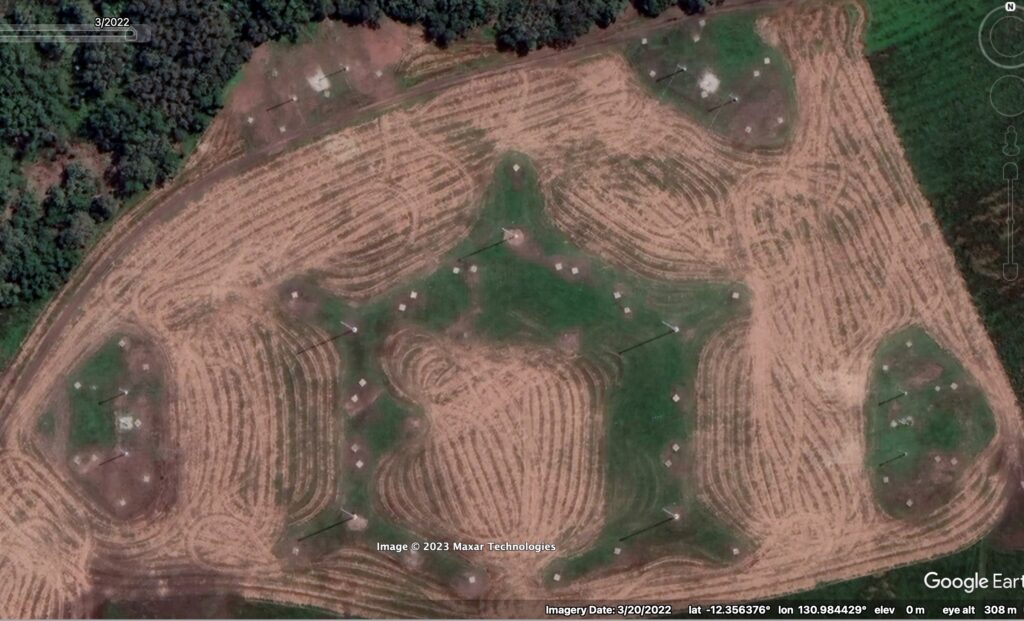
Shoal Bay Receiving Station, Darwin Google Earth, 20 March 2022 – HF antenna farm
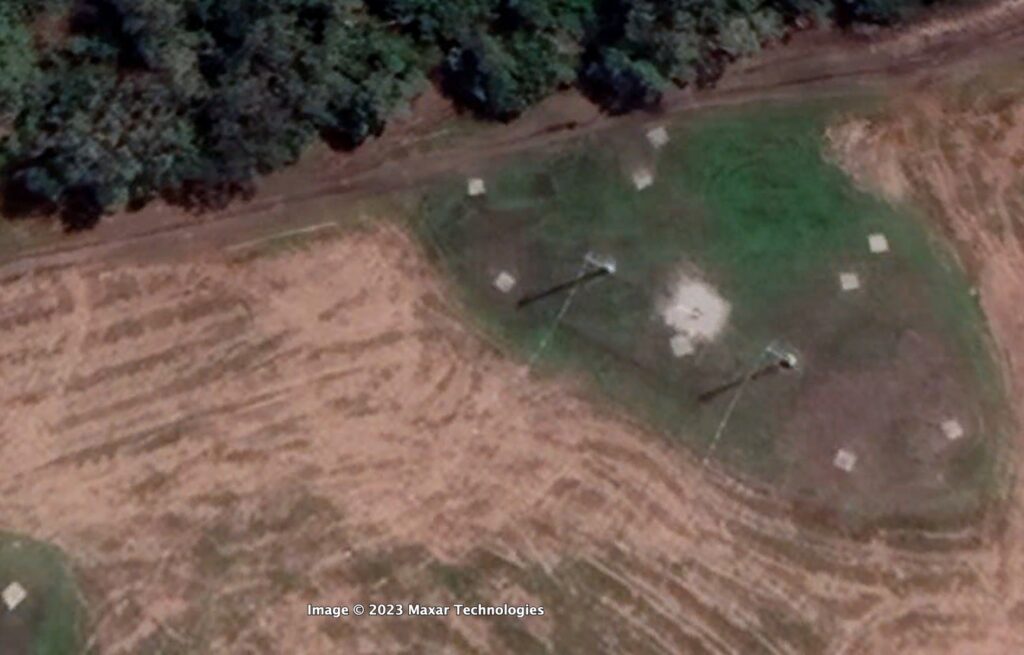
Shoal Bay Receiving Station, Darwin Google Earth, 20 March 2022 – HF antenna farm, curtain antennas.
Government sources
HMAS Coonawarra, Royal Australian Navy
Shoal Bay, prior to December 2000
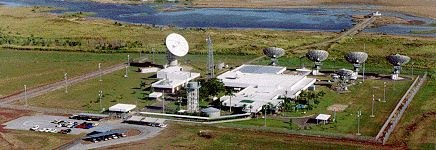
- Defence Department photograph of Shoal bay receiving Station published in 2000: The quiet achiever, Navy News, December 11, 2000. http://www.defence.gov.au/news/navynews/editions/2000/12_11_00/story13.htm
Source: The quiet achiever, Navy News, December 11, 2000.
Parlimentary sources
Shoal Bay Receiving Station, Questions in Writing, House of Representatives, (Question No. 5451),
Question
“Mr Melham (Banks) asked the Minister for Defence, in writing, on 15 February 2007:
(1) How many personnel currently work at the Shoal Bay Receiving Station in Darwin, Northern Territory.
(2) Which private contractors currently provide personnel or deliver services to the Shoal Bay Receiving Station.”
Answer
Dr Nelson (Bradfield—Minister for Defence)—The answer to the honourable member’s question is as follows:
(1) 73.
(2) Boeing Australia, Serco Sodexho, Spotless and Chibb. Raytheon also undertakes some work at the site as a subcontractor to Boeing.”
Shoal Bay Receiving Station, Questions in Writing, House of Representatives, (Question No. 2327), 1 November, 2005.
Question
“Mr Melham (Banks) asked the Minister representing the Minister for Defence, in writing, on 7 September 2005:
(1) How many personnel currently work at the Shoal Bay Receiving Station in Darwin, Northern Territory.
(2) How many personnel employed at the Shoal Bay Receiving Station are (a) Australian Department of Defence personnel, (b) Australian Defence Force personnel, (c) employees of Australian contractors, and (d) any other personnel.
(3) Which private contractors provide personnel or deliver services at the Shoal Bay Receiving Station.
(4) What was the cost to the Australian Government of running the Shoal Bay Receiving Station for each financial year since 1996-97.
(5) Since March 1996, have any Federal or State Members of Parliament (a) visited the Shoal Bay Receiving Station and (b) received classified briefings on the functions of the station; if so, which Members and when did the visits and briefings take place.
(6) How many radomes and satellite antenna are located at the Shoal Bay Receiving Station.
(7) What functions are performed by the Shoal Bay Receiving Station.
Answer
Mrs De-Anne Kelly (Dawson—Minister for Veterans’ Affairs)—The Minister for Defence has provided the following answer to the honourable member’s question:
(1) 85.
(2) Detailed staffing information regarding the operations of Shoal Bay Receiving Station is classified. The Parliamentary Joint Committee on ASIO, ASIS and DSD conducts a review of the annual financial and administrative aspects of DSD’s operations. This review includes details of the staff and budget for Shoal Bay Receiving Station.
(3) Boeing Australia, Serco and Chubb. Raytheon undertakes some work at the site as a subcontractor to Boeing.
(4) Detailed financial information regarding the operations of Shoal Bay Receiving Station is classified.
(5) The following Federal and State Members of Parliament have visited Shoal Bay Receiving Station since 1996 and received briefings as indicated.
(a) August 2000: The Hon John Moore MP, Minister for Defence, received a classified briefing.
(b) 21 May 2002: The Hon Robert Hill MP, Minister for Defence, received a classified briefing.
(c) 9 July 2002: Joint Standing Committee on Foreign Affairs, Defence and Trade: the Hon David Jull MP, Senator Sandy McDonald, Senator the Hon Paul Calvert, Senator the Hon Robert Ray, the Hon Kim Beazley MP, Mr Stewart McArthur MP, and the Hon Leo McLeay MP, received a classified briefing.
(d) 16 July 2003: Joint Standing Committee on Foreign Affairs, Defence and Trade: The Hon Bruce Scott MP, the Hon Roger Price MP, the Hon Kim Beazley MP, Senator Alan Ferguson, the Hon Warren Snowdon MP, Senator Sandy McDonald – received a classified briefing.
(6) No radomes, 17 antennas.
(7) The station is managed by the DSD and is operated in cooperation with other parts of the Department of Defence and the Australian Defence Force. The operational details of the facility are classified.
Analysis and commentary
Shoal Bay Receiving Station, Wikipedia.
Desmond Ball, “Silent Witness: Australian intelligence and East Timor”, Masters of Terror: Indonesia’s Military and Violence in East Timor in 1999, [co-edited with Desmond Ball and Gerry Van Klinken], (New York: Rowman and Littlefield, second edition, 2006).
“DSD’s largest intercept station is located at Shoal Bay, near Darwin, where some 120-150 people worked through 1999, listening with earphones to Indonesian radio traffic, recording encrypted signals, and monitoring satellite telephone conversations.
“The Shoal Bay station has two different signals interception systems. One is a large circular antenna array, code-named Pusher, which is used for interception, monitoring, direction-finding (DF) and analysis of radio signals in the high frequency (HF) band. This system intercepted radio communications among ABRI and militia units in East Timor, between ABRI officers in the field and the East Timor Command in Dili, between Dili and the HQ of the Udayana Regional Military Command or KODAM (Komando-Daerah Militer) IX in Denpasar in Bali, and between Dili and ABRI HQ in Jakarta.
“The second system, code-named Larkswood, is concerned with the interception of Indonesian satellite communications, and especially those involving Indonesia’s own Palapa communications satellite system. It became operational in 1979, and during its first decade had only two dish antennas, for monitoring the two Palapa satellites then in service. In the late 1980s, according to the then Minister for Defence, ‘the station [was] modified in response to changing requirements and this included the installation of several dish antennas’. These must have been temporary, because at the time of the massacre at the Santa Cruz cemetery in Dili in November 1991, there were still only two dish antennas. But many more were installed in the late 1990s, making eleven as at September 1999 (including two small dishes on the roof of the main operations building). Most of the new antennas were designed to intercept various sorts of satellite communications involving Indonesia, including mobile satellite telephone (satphone) conversations using INMARSAT and other services. By 1998, it seemed that ABRI officers throughout the archipelago were using satphones more than their Army radios to communicate with Jakarta. Some of the new dishes were installed to provide direct relay of the intercepted material, as well as ‘first echelon’ translations and analyses, to the DSD HQ and the DSD liaison offices in the ONA and DIO buildings at Russell Hill.
“In addition, small teams of Navy SIGINT personnel from Shoal Bay served aboard some of the Navy’s frigates and patrol boats, which were able to operate close to East Timor. These teams intercepted VHF/UHF transmissions as well as low-power HF signals, such as walkie-talkie and field radio communications. DSD was also able to use two P-3C Orion aircraft which had been specially configured for SIGINT operations in 1995-98 (under Project Peacemate).”
Desmond Ball, ‘The Defence Presence in the Northern Territory’, in Desmond Ball and J.O. Langtry (eds), The Northern Territory in the Defence of Australia: Geography, History, Economy, Infrastructure and Defence Presence, (Canberra Papers on Strategy and Defence No.63, Strategic and Defence Studies Centre, Australian National University, Canberra, 1990), pp.250-258.
Australia’s Secret Space Programs, Desmond Ball, Canberra Papers on Strategy and Defence No 43, 1988, chapter 3.
Naval Communication Station (NCS), Darwin (Northern Territory), Systems Support and Operations, Boeing Australia.
“Boeing Australia is the prime contractor for the operation and maintenance of the Transmit and Receive sites associated with the Naval Communications Station located in Darwin. The Transmit site located at Humpty Doo, 65 kms south of Darwin, operates approximately 30 high powered, High Frequency (HF) radio transmitters and over 40 HF aerials. The receive site is located at Shoal Bay, approximately 25 kms north-east of Darwin. Together these two sites provide the HF communications capability for the Royal Australian Navy (RAN) from northern Australia.”
Shoal Bay and East Timor
Death in Balibo, Lies in Canberra, Desmond Ball and Hamish McDonald, Allen and Unwin, Sydney, 2000.
Brian Peters Findings, Coronial Findings and Recommendations, Coroner’s Court New South Wales, especially Chapter 9 “SIGINT”, pp 74-93.
Spying game keeps its peace, Hamish McDonald, Sydney Morning Herald, 3 March 2007
See also
- ADF bases and locations abroad
- Australian intelligence organisations, Australian Forces Abroad, Nautilus Institute
- Australian Defence Satellite Communications Station, Geraldton, Australian Defence Facilities, Nautilus Institute

